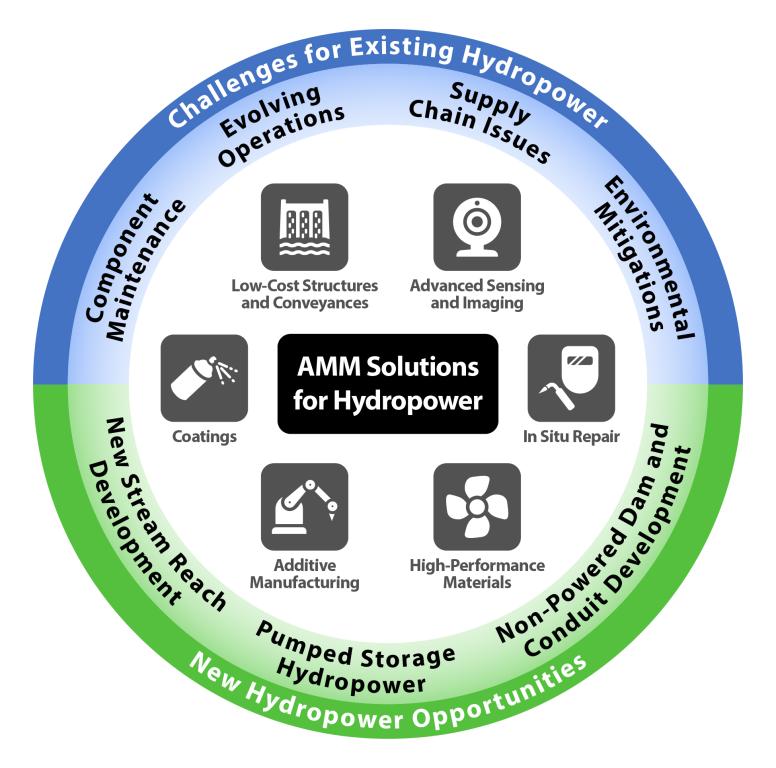
Overview/Objectives
Over 100 years ago, the hydropower industry, which today generates nearly 6% of all US energy, was built using traditional manufacturing processes. Surging energy demand, higher material costs, and supply chain hurdles have led researchers to rethink manufacturing to address higher repair and maintenance costs, lost revenue due to necessary plant outages, and a lag between current manufacturing capabilities and the technological innovations needed to propel the industry forward.
To ensure hydropower’s continued success as a resilient, secure energy source, the US Department of Energy’s (DOE’s) Water Power Technologies Office tasked Oak Ridge National Laboratory to explore how advanced manufacturing and materials could more easily and cost-effectively modernize the existing fleet and facilitate further innovations in design.
To kick things off, ORNL hosted an in-person workshop in 2022 at the lab’s Manufacturing Demonstration Facility (MDF). Participants representing industry, research, and academia discussed current challenges, including the cost and availability of replacement parts and new supply chain backlogs, as well as how large-scale advanced manufacturing and novel materials could modernize the hydropower fleet – often at a lower cost and in a shorter time frame. ORNL researchers also collected feedback from other key stakeholders in targeted interviews.
Results
The 2022 workshop resulted in the creation of a report called "Advanced Manufacturing and Materials for Hydropower: Challenges and Opportunities," which was released in March 2023. In it, the ORNL team identified the primary manufacturing challenges confronting the hydropower industry:
- Aging infrastructure and components – Repairs are needed on four main systems: turbines and generators, pressurized conduits and gates, structures and foundations, and electrical systems and controls.
- Supply chain issues – Most high-quality large metal components are no longer manufactured in the United States, leading to shortages of materials and electronics and significantly longer lead times.
- Environmental mitigations – Transitioning to more environmentally-friendly hydropower will require adoption of new technologies with additional costs.
- Evolving operational standards – Environmental change and increasing energy demands will necessitate new operating strategies and technologies to maximize hydropower’s value to the grid, as well as innovative development to capture the available hydropower potential.
The report also identified advanced manufacturing capabilities that could be employed as an alternative to current manufacturing processes:
- Additive manufacturing – Constructing parts layer-by-layer can optimize the design and enable manufacturing of parts on site. Potential applications include embedded sensors, aerating vents, and cooling channels.
- Novel machining and casting processes – Combining additive and subtractive manufacturing, as well as 3D printing of sand molds can help return production of large parts back to the US. This could enable faster production and result in higher-quality parts.
- Innovative materials – These lower-cost/higher performance material alternatives are often lighter, stronger, more resistant to cavitation and corrosion, easier to repair, and more environmentally friendly. Potential applications include runners, composite bearings, pipelines and conduits, and wicket gates.
- Novel coating processes – New coatings can mitigate many common failures of systems and parts, such as those resulting from biofouling, corrosion, and cavitation. These new processes may reduce toxicity and improve component durability.
Impact
In February 2024, the WPTO released a guiding strategy document based on the ORNL researchers’ work. Continued collaboration is expected to provide further insights into the specific challenges facing the US hydropower fleet and identify those advanced manufacturing processes and materials that may best address these challenges. The dissemination of these findings may stimulate adoption of technological innovations that further position hydropower as an independent, resilient source of energy that is safe and secure for local communities, eco-systems, and the environment.




